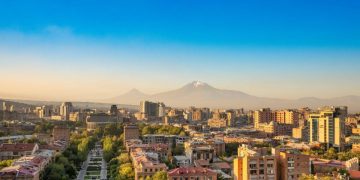The 2024 US presidential election on 5th November will see Vice President Kamala Harris face off against former President Donald Trump.
Although around 240 million Americans are eligible to vote, the outcome will largely depend on a small number of people in key swing states. This is because US presidential elections are decided by the electoral college, not the national popular vote. Each state’s electoral votes for president, which are proportional to its population, are awarded in a “winner-takes-all” system in most states.
In 2020, President Joe Biden narrowly flipped several key states from Republican “red” to Democrat “blue” to defeat Trump. In 2024, similarly slim margins in these battleground states will decide whether Trump makes a return to office — or Harris whether ascends to the White House as the first female president in American history.
According to experts, the six states to watch are Arizona, Georgia, Michigan, Nevada, Pennsylvania and Wisconsin. Below, Politics.co.uk has compiled all the must-know facts about each contest in this first piece of a new series on the US presidential election:
Arizona
- Electoral College Votes: 11/538
- State population: 7.4 million people
- 2020 winner: Biden by 10,000 votes
- Demographics: A majority of Arizona is White (52.9%), with 5.5% being Black or African American and 5.2% being American Indian or Alaska Native.
- Polling average: Even at 47.1%
In past presidential elections, Arizona has often backed Republican presidential candidates, including Trump in 2016. However, in 2020, Biden narrowly flipped the state. With Arizona’s 11 electoral votes once again at stake, both Trump and Harris have made frequent campaign stops, addressing key national issues such as the economy, immigration and abortion to appeal to voters.
The state has hundreds of miles of border with Mexico and has become a central focus of the national immigration debate. While border crossings have recently declined from record highs at the end of 2023, the issue remains a top concern for voters. Trump has consistently criticised Harris’s handling of immigration, with Biden having tasked her to address the border crisis.
Arizona has also been at the centre of a heated debate over abortion access, following state Republicans’ unsuccessful attempt to reinstate a near-total ban on abortion dating back 160 years. The issue has become even more divisive following the US Supreme Court’s 2022 decision to overturn the landmark ruling that had granted women the constitutional right to abortion.
***Politics.co.uk is the UK’s leading digital-only political website. Subscribe to our daily newsletter for all the latest news and analysis.***
Georgia
- Electoral college votes: 16/538
- State population: 11 million people
- 2020 winner: Biden by 13,000 votes
- Demographics: Just over half (50.4%) of Georgia’s population is non-Hispanic White. Almost a third (33.1%) is Black or African American, while 10.5% is Hispanic and 4.8% is Asian.
- Polling average: Trump +0.4% | Trump 47.5% / Harris 47.2%
When Biden narrowly won Georgia in 2020, he became the first Democratic candidate to do so since 1992. The Harris-Walz campaign is now working hard to secure the state again, while the GOP is focusing on key voting blocs, particularly in the suburbs of metro Atlanta. Georgia’s 16 electoral votes are crucial; without them, Trump’s path to victory in 2024 would become much more challenging.
African Americans make up a third of Georgia’s population – one of the largest Black communities in the US, and this demographic played a key role in Biden’s 2020 victory. While there have been reports of disillusionment among Black voters, the Harris campaign is making Georgia a priority and aims to re-energise this important constituency.
In Georgia, voters’ perceptions of the economy are also critical. The state is experiencing economic growth, fuelled by investments in emerging industrial sectors like battery manufacturing. The White House credits this to “Bidenomics,” highlighting it as a success of the current administration’s policies. However, Republicans argue that Biden’s actions are, in fact, damaging growth.
Georgia is also the site of one of Trump’s four criminal cases. The Fulton County district attorney has indicted the former president for allegedly interfering in the 2020 election, charging him with multiple conspiracies and violations of Georgia’s racketeering laws.
Michigan
- Electoral college votes: 15/538
- State population: 10 million
- 2020 winner: Biden by 150,000 votes
- Demographics: Almost three-quarters (74%) of Michiganders are White, while the state also has a significant Black population at 14.1%. The Hispanic population is the next largest group, accounting for 5.7%.
- Polling average: Harris +2.5% | Harris 48.2% / Trump 45.7%
Michigan had been a reliably Democratic state for decades until Trump’s 2016 campaign, when he pulled off a major upset by defeating Hillary Clinton, thanks in large part to his appeal among White working-class voters. Trump won the state by fewer than 11,000 votes.
In 2020, however, Biden won Michigan in a relative landslide by 150,000 votes. With 15 electoral votes in November, Michigan is more diverse than other key “blue wall” states, which could work in Harris’s favour.
Among the Rust Belt swing states (Wisconsin, Michigan, and Pennsylvania), Michigan has recently been the most favourable for Democrats. The party has performed better there than in the other two states in every presidential election since 2000. Democrats now control all four statewide constitutional offices, both US Senate seats and both chambers of the state legislature. This year, however, operatives from both parties view Michigan as a more challenging battleground for Harris compared to Wisconsin.
Harris faces challenges particularly with the country’s largest Arab-American community and amongst young voters, many of whom have voiced dissatisfaction with the Biden administration’s response to the war in Gaza. In Michigan’s Democratic primary in February, over 100,000 voters selected the “uncommitted” option, part of a movement led by activists calling for the U.S. to stop military aid to Israel.
Michigan Democrats are also contending with efforts by Trump to convince auto workers that the Biden administration’s push to accelerate the transition to electric vehicles will cause domestic jobs losses.
***Politics.co.uk is the UK’s leading digital-only political website. Subscribe to our daily newsletter for all the latest news and analysis.***
Nevada
- Electoral college votes: 6/538
- State population: 3.2 million people
- 2020 winner: Biden by 34,000 votes
- Demographics: Less than half of its population (45.7%) is non-Hispanic White, while 30.3% is Hispanic. The Black or African American population makes up 10.8%, and the Asian population accounts for 9.4%.
- Polling average: Harris +1.1% | Harris 47.3% / Trump 46.2%
The Silver State has not voted for a Republican presidential candidate since 2004. Unlike Rust Belt states in the Midwest, Nevada has a large and growing non-White population with about 40% of eligible voters being Latino, Black, or Asian American Pacific Islanders – demographic groups that tend to support Harris more than Trump. Yet, there are growing signs of a potential shift towards Trump.
Concerns over living costs, inflation, and immigration could give Trump an advantage. Despite the U.S. economy experiencing strong growth and job creation under Biden, Nevada’s post-Covid recovery has been slower than most states, with the state’s near 5% unemployment rate being among the highest in the country after California and D.C. Nevada has a massive service worker industry operating in Las Vegas and Trump has promised to revive his agenda of lower taxes and fewer regulations if re-elected.
Poll averages show that while Trump previously held a significant lead over Biden, his advantage has narrowed since Harris took over as the Democratic nominee. Democrats are hoping her appeal to younger and more diverse voters will close the gap that Biden struggled to shore up. Both campaigns are targeting working class voters here.
Pennsylvania
- Electoral college votes: 19/538
- State population: 13 million people
- 2020 winner: Biden by 82,000 votes
- Demographics: In Pennsylvania, 74.5% of the population is non-Hispanic White, with Black or African American individuals at 12.2% and Hispanics at 8.6%. The state also has a higher proportion of older adults, with 19.6% aged 65 and older, above the national average of 17.3%.
- Polling average: Harris +1.9% | Harris 48.3% / Trump 46.4%
Pennsylvania is considered by most experts to be the tipping point state, meaning whoever carries it is likely to win the White House. As such, the state has become arguably the main focus for both campaigns.
Since Harris became the Democratic candidate in July, the campaign has allocated more advertising funds to Pennsylvania than to any other state, with Michigan coming in second and Wisconsin fourth, according to data from AdImpact, an advertising tracking service.
From 1992 to 2012, the state voted for Democratic presidential nominees, but in 2016 Trump’s populist message resonated with many White working-class voters without college degrees, who make up roughly half of the state’s eligible voters. Trump continues to maintain strong support among this group. However, high turnout in major cities like Pittsburgh and Philadelphia could swing the state in favour of Harris.
The economy is a key concern in Pennsylvania, as in much of the country. While inflation surged under the Biden administration and has since moderated, Pennsylvanians have felt the strain, especially with grocery prices rising faster in their state than anywhere else, according to analysis from ConsumerAffairs.
***Politics.co.uk is the UK’s leading digital-only political website. Subscribe to our daily newsletter for all the latest news and analysis.***
Wisconsin
- Electoral college votes: 10/538
- State population: 5.9 million people
- 2020 winner: Biden by 21,000 votes
- Demographics: About 80.1% of Wisconsinites are White, according to the U.S. Census Bureau estimates. The next largest racial or ethnic groups are Hispanic individuals at 7.6% and Black or African American individuals at 6.6%.
- Polling average: Harris +2.7% | Harris 48.7% / Trump 46.0%
In Wisconsin, the presidential contest is generally exceptionally close and has often been decided by less than 1% of the vote. With a population of nearly 6 million, just 20,000 votes can sway the outcome.
Harris hopes to help rebuild the Democrats’ “blue wall” in the state, while Trump aims to dismantle it, as he did in 2016. Milwaukee hosted the summer Republican National Convention, underscoring the state’s critical role in the election.
Pundits suggest that in closely contested states like Wisconsin, third-party candidates could have a significant impact by drawing votes away from the main contenders. Polls show that independent candidate Robert F. Kennedy Jr., who is still on the ballot in the state despite withdrawing from the race, could affect vote totals for both Harris and Trump.
Additionally, Democrats are working to have Green Party candidate Jill Stein removed from the ballot, alleging non-compliance with state election laws, and have filed a complaint against Cornel West, a left-leaning academic. Many experts contend that Trump was able to win the Badger State in 2016 because of a sizeable vote going to third-party Libertarian candidate Gary Johnson.
In 2024, Democrats will focus their campaign on abortion rights, a strategy that has previously proven effective in Wisconsin and helped elect a pro-abortion rights advocate to the state’s highest court last year. Meanwhile, Republicans in the state legislature are pushing to further restrict access to abortions. Although Wisconsin has a robust agricultural economy, Democrats believe that women and young adults in college towns will be key to securing their vote.
Politics.co.uk is the UK’s leading digital-only political website. Subscribe to our daily newsletter for all the latest news and analysis.
The post Trump vs. Harris: The six states that will decide the 2024 US presidential election appeared first on Politics.co.uk.

































